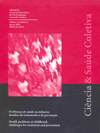0756/2007 - Prevalência de Respiradores Bucais em crianças de idade escolar
Prevalence of mouth breathing in childrenan elementary school
Autor:
• Josiane Marques Felcar - Felcar, J.M. - Londrina, PR - Universidade Norte do Paraná - UNOPAR - <josianefelcar@sercomtel.com.br>Área Temática:
Não CategorizadoResumo:
Objetivo:Identificar a prevalência de respiradores bucais em crianças de uma escola do ensino fundamental.Materiais e métodos:Foram aplicados 496 questionários aos pais ou responsáveis das crianças de 1ª à 4ª série de uma escola fundamental, para identificar respiradores bucais. O questionário incluía questões sobre hábitos, sono, comportamento, alimentação, cuidados pessoais e respiração. Para comparar as variáveis entre respiradores bucais e nasais foi utilizado o teste de Mann-Whitney e Qui-quadrado. Para medir o efeito da exposição das variáveis explicativas sobre o desfecho primário foi utilizada regressão logística e sua magnitude foi calculada por meio do Odds Ratio. A significância estatística foi estipulada em 5%.
Resultados:A taxa de devolução dos questionários foi de 84.5%. A prevalência de respiração bucal nessa população foi 56.8%. A mediana de idade foi 7 anos (6-9). Não houve diferença estatisticamente significante entre os gêneros, 49,1% masculino e 50,9% feminino. O modelo final de regressão logística identificou as variáveis baba, dorme bem (associação negativa) e ronca como fatores que predizem a ocorrência da respiração bucal.
Conclusão:A prevalência de respiradores bucais foi semelhante à encontrada na literatura pesquisada. As variáveis babar, roncar e dormir bem (associação negativa) podem predizer a ocorrência da respiração bucal.
Palavras-chave:respiração bucal; prevalência; criança; pediatria.
Abstract:
Objective: To identify the prevalence of mouth breathing in children from an elementary school.Materials and Methods: 496 questionaries were answered by 1st and 4th grade children’s parents or sponsors, in order to identify mouth-breathing. There were questions about habits, sleeping, behavior, eating, personal care and breathing. Mann-Whitney and the Chi-square tests were used to compare the variables between mouth-breathing and nose-breathing among the groups. To measure the exposure effect of the explanatory variables on mouse breathing, the test of logistic regression was used and its magnitude was calculated through Odds Ratio. The statistical significance was set at 5%.
Results: The rate of returned questionnaires was 84.5%. The prevalence of the mouth-breathing over this population was 56.8%. The average age was 7 years old (6-9). There was no significant statistical difference between genders, considering 49,1% male and 50,9% female. The final model of logistic regression identified the variables dribble, sleeps well (negative association) and snores as factors that predict the occurrence of the mouth-breathing.
Conclusion: The prevalence of mouth-breathing was similar to related in the literature. The variables dribble, sleeps well (negative association) and snores may be factors that predict the occurrence of mouth-breathing.
Key words: mouth-breathing; prevalence; child; pediatrics.













